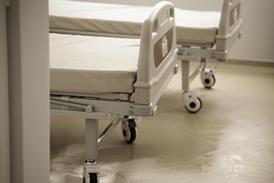Increasing the number of nurses is expensive, but if hospitals do so they can significantly reduce patients’ length of stay and mortality rates, writes Jenny Kay
“If we paid as much attention to workforce planning as to the operational management of the 18 week target, we could have avoided the whole Francis enquiry.” So said an experienced director of operations after reading the harrowing account of the failures at Mid Staffordshire.
‘It has been argued that if the authorities set minimum staffing levels the “floor” will soon become the “ceiling”’
Given the imperative of keeping patients safe in hospital, it certainly makes sense to approach the challenge of setting staffing levels in a more analytical and systematic way than has often been the case in the past.
It defies logic that the care of some of our most vulnerable elderly patients on general medical and surgical wards is left purely to local determination. Midwives have developed their well accepted Birthrate Plus workforce tool and intensive care and stroke units are all staffed to common standards, so why can this not be agreed for general acute wards?
It has been argued that each ward is different, with a different case mix and layout, and staffing levels should therefore be locally determined. It has also been argued that if the authorities set minimum staffing levels, the “floor” will soon become the “ceiling” and it will not be long before all hospitals plummet towards the bargain basement.
A misleading ratio
A group of nurse leaders is now challenging that long held assumption. The Safe Staffing Alliance is made up of NHS directors of nursing, senior healthcare academics, leaders of professional organisations and the Patients Association.
The alliance points to the current variation in staffing levels. Recent research by King’s College London shows that in some NHS hospitals registered nurses will provide care to an average of five named patients during a shift, while in other hospitals nurses have up to 11 patients to care for. Research has found considerable variation between and within hospitals even when specialty and patient dependency are taken into account.
‘Registered nurses must at all times be supported by a sufficient number of nursing assistants and support staff’
Benchmarking can be a useful tool and is also commonly used as a comparative “sense check”. However, if used at an aggregated trust level it can mask underlying risks. Many directors of nursing have witnessed turnaround teams who suggest staffing can be reduced, on the basis of a comparative overall trust nurse-to-bed ratio.
This crude trust wide “nurse-to-furniture” ratio (as it is becoming known) can be highly misleading, as it will often include all nursing and midwifery staff in a trust. For example, outpatient and specialist nurses, intensive care nurses and midwives, which necessarily vary markedly between different trusts with different service profiles. It is also fair to say that in most trusts the number of beds is a variable feast, as escalation beds are put up and taken down on a daily basis.
From a patient perspective, the only question that really matters is: “Is there a competent, compassionate nurse to look after me when I need care today?”
Strong principles
For a ward sister, that will translate into: “How many registered nurses are on the shift today to care for my patients?” These are the questions that the Care Quality Commission asks when it inspects trusts, as I also do as a commissioner on my visits to providers.
The CQC’s national inpatient survey results reveal that only 59 per cent of patients felt that there were “always or nearly always enough nurses to look after them”. In a post Francis report era when we should be listening to patients as never before, is this good enough?
Equally, the national NHS staff survey shows that only a third of all staff believe that they have enough people to do the job properly. Nurses are mostly sensible, pragmatic people. But when they go home “leaving care undone” they feel their professional integrity is undermined by a system that condones poor care. In the short term this leaves a sense of powerlessness and frustration and in the long run it causes emotional burn out.
This is why the Safe Staffing Alliance is promoting a set of staffing principles. These include the determination of safe registered nurse staffing levels. We are also calling for a requirement to publish information on registered nurse numbers at ward level, in addition to an annual report on nurse staffing agreed by the board of every organisation.
Registered nurses must at all times be supported by a sufficient number of nursing assistants and support staff, such as cleaners and ward clerks. The care of patients and families should be overseen by a supervisory ward sister or charge nurse on every ward, who is not counted in the shift numbers.
Courage and compassion
A study by researchers at Southampton University, King’s College London and the National Nursing Research Unit found that hospitals with eight patients per registered nurse (during the day time on general acute wards) would see around 20 extra deaths a year more than better staffed hospitals.
‘We need courage to speak up and take action when staffing levels fall so low that patient safety is put at risk’
This research also reveals that 40 per cent of trusts do not achieve this 8:1 level on all their wards. A statement issued by the alliance to coincide with International Nurses Day emphasises: “For the sake of clarity, more than eight patients per registered nurse is the level considered to be unsafe and putting patients at risk. It is not a recommended minimum. For nurses to provide compassionate care which treats patients with dignity and respect, higher levels will be needed and these should be determined by every health care provider.”
It may seem counterintuitive to argue for a new approach to staffing at a time when ever tougher efficiency savings are being asked for. Increasing the number of nurses is expensive − it would cost £1.5 million for an NHS trust to employ 50 more registered nurses. However, the investment makes sense when considering the cost and quality benefits.
My own experience as a director of nursing in an acute trust showed when we increased staffing levels and appointed supervisory ward sisters, we saw a significant overall reduction in length of stay, improved identification of deteriorating patients and reduced mortality rates.
NHS England’s chief nursing officer, Jane Cummings, calls for courage and compassion. When it comes to safe staffing levels the two go hand in hand. We need courage to speak up and take action when staffing levels fall so low that patient safety is put at risk. Only then can compassionate care flourish in all our hospital wards.
Jenny Kay is director of quality at Merton CCG and a member of the Safe Staffing Alliance




























3 Readers' comments